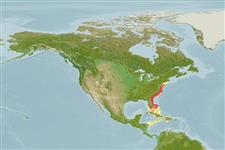>
Eupercaria/misc (Various families in series Eupercaria) >
Sciaenidae (Drums or croakers)
Etymology: Cynoscion: Greek, kyon = dog + Greek, odous = teeth + Greek, skion, skiaina = barbel, red mullet (Ref. 45335).
More on author: Cuvier.
Environment: milieu / climate zone / depth range / distribution range
Ecologia
marinhas; estuarina demersal; não migratória (Ref. 94474); intervalo de profundidade 10 - ? m (Ref. 9988). Subtropical; 42°N - 15°N, 83°W - 70°W (Ref. 94474)
Western Atlantic: New York to southern Florida in USA and the entire Gulf of Mexico. Northeastern Atlantic: recently reported from Guadalquivir River estuary in Spain (Ref. 94474).
Comprimento de primeira maturação / Tamanho / Peso / Idade
Maturity: Lm 26.8, range 25 - 35 cm
Max length : 100.0 cm TL macho/indeterminado; (Ref. 40637); common length : 36.0 cm TL macho/indeterminado; (Ref. 3702); peso máx. publicado: 7.9 kg (Ref. 40637); idade máx. registrada: 18 anos (Ref. 12193)
Espinhos dorsais (total) : 9 - 11; Raios dorsais (total) : 25 - 28; Espinhos anais: 2; Raios anais : 10 - 11. Body silvery, dark grey on back with bluish reflections and numerous round black spots irregularly scattered on upper half, extending to dorsal and caudal fin. Spinous dorsal fin dusky, other fins pale to yellowish. Mouth large, oblique lower jaw projecting. Upper jaw with a pair of large canine-like teeth at tip. Lower jaw with an enlarged inner row of teeth, uniform in size and closely set. Chin without barbels or pores. Snout with 2 marginal pores. Gas bladder with a pair of nearly straight horn-like appendages. Soft portion of dorsal fin unscaled (Ref 51721).
Inhabits river estuaries and shallow coastal marine waters over sand bottoms, often associated with seagrass beds. Also occurs in salt marshes and tidal pools of high salinity. Feeds mainly on crustaceans and fishes. An important food and sport fish throughout its range. Utilized fresh for steaming, broiling and baking (Ref. 9988).
Robins, C.R. and G.C. Ray, 1986. A field guide to Atlantic coast fishes of North America. Houghton Mifflin Company, Boston, U.S.A. 354 p. (Ref. 7251)
Status na Lista Vermelha da UICN (Ref. 130435)
Ameaça para os humanos
Harmless
Uso pelos humanos
Pescarias: espécies comerciais; peixe esportivo: sim
Ferramentas
Relatórios especiais
Baixar XML
Fontes da internet
Estimates based on models
Preferred temperature (Ref.
123201): 12 - 26.7, mean 24.3 °C (based on 88 cells).
Índice de diversidade filogenética (Ref.
82804): PD
50 = 0.5000 [Uniqueness, from 0.5 = low to 2.0 = high].
Bayesian length-weight: a=0.00813 (0.00502 - 0.01317), b=3.05 (2.92 - 3.18), in cm total length, based on LWR estimates for this species & Genus-body shape (Ref.
93245).
Nível Trófico (Ref.
69278): 4.0 ±0.66 se; based on food items.
Generation time: 5.8 (4.0 - 6.7) years. Estimated as median ln(3)/K based on 13
growth studies.
Resiliência (Ref.
120179): médio(a), tempo mínimo de duplicação da população 1,4 - 4,4 anos (K=0.2-0.3; tmax=18; tm=1; Fec=1 million).
Prior r = 0.69, 95% CL = 0.46 - 1.04, Based on 1 data-limited stock assessment.
Fishing Vulnerability (Ref.
59153): High vulnerability (58 of 100).
Climate Vulnerability (Ref.
125649): High vulnerability (60 of 100).
Nutrients (Ref.
124155): Calcium = 43.1 [25.3, 82.0] mg/100g; Iron = 0.771 [0.408, 1.320] mg/100g; Protein = 19.1 [17.7, 20.8] %; Omega3 = 0.33 [0.20, 0.51] g/100g; Selenium = 30.9 [16.5, 56.8] μg/100g; VitaminA = 9.52 [3.34, 29.64] μg/100g; Zinc = 0.667 [0.495, 0.966] mg/100g (wet weight);
